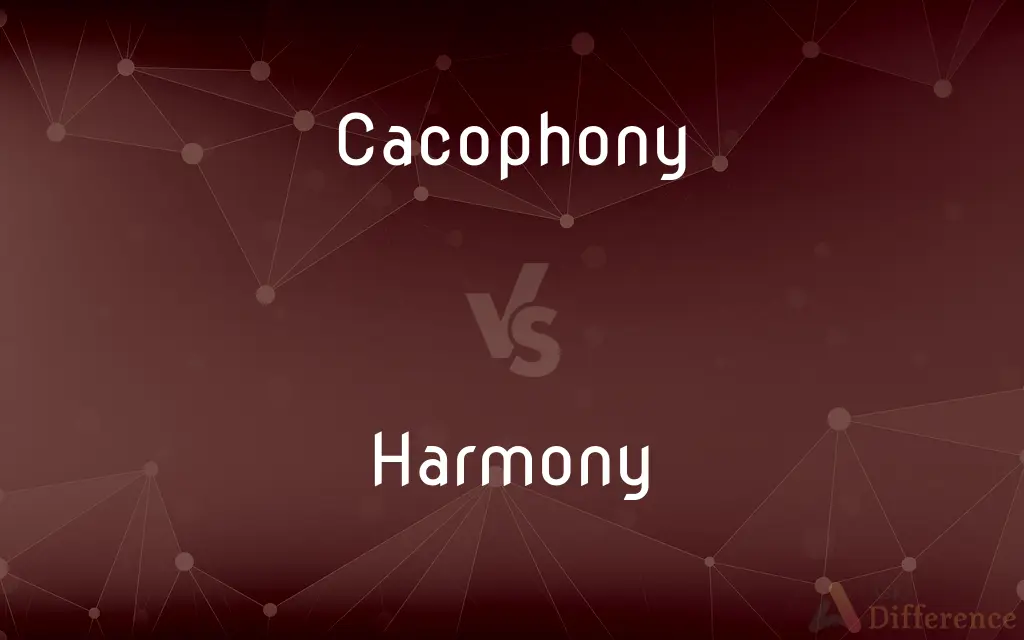Cacophony vs. Harmony — What's the Difference?
By Urooj Arif & Maham Liaqat — Updated on May 3, 2024
Cacophony refers to a harsh, discordant mixture of sounds, while harmony describes a pleasant and congruent arrangement of tones.

Difference Between Cacophony and Harmony
Table of Contents
ADVERTISEMENT
Key Differences
Cacophony is often associated with noise and unpleasant soundscapes, such as the clashing of horns in a traffic jam, whereas harmony represents a blend of musical notes or sounds that are aesthetically pleasing, as found in choir singing or in symphonies.
In literature, cacophony is used to convey disorder or conflict within a narrative, employing jarring, discordant phonetics to enhance a setting or mood; on the other hand, harmony in writing might be used to create a peaceful, serene atmosphere through smooth and flowing word choices.
From a psychological perspective, cacophony can cause feelings of irritation or discomfort, suggesting a chaotic or stressful environment. In contrast, harmony tends to induce calmness and a sense of well-being, often used therapeutically in stress reduction and meditation.
In terms of auditory perception, cacophony can result from a lack of synchronization among sounds, leading to a noisy or jumbled auditory experience. Conversely, harmony involves the intentional organization of pitches to create chords that are pleasing to the ear.
Environmental sounds can also be described as cacophonous or harmonious. For example, urban environments often have a cacophony of sounds from traffic and construction, while natural settings may feature the harmonious sounds of birdsong and wind through trees.
ADVERTISEMENT
Comparison Chart
Definition
Harsh, discordant sound mix
Congruent, aesthetically pleasing tones
Associated Feel
Irritation, discomfort
Calmness, pleasure
Usage in Music
Dissonant, clashing sounds
Chords that fit well together
Literary Device
Reflects conflict, disorder
Enhances peaceful, serene settings
Psychological Impact
Can increase stress
Reduces stress, promotes relaxation
Compare with Definitions
Cacophony
A situation where there is a lot of noise that sounds unpleasant.
The construction site was a cacophony early in the morning.
Harmony
The combination of simultaneously sounded musical notes to produce chords.
The choir's harmony during the chorus was breathtaking.
Cacophony
Sound that lacks harmony or agreement.
The beginner's orchestra created quite a cacophony.
Harmony
A pleasing arrangement of parts.
The garden was designed with a sense of harmony and balance.
Cacophony
In literature, a use of words with sharp, harsh sounds.
The poet used cacophony to express the chaos of the battle.
Harmony
In music, any simultaneous combination of tones.
The composer used complex harmonies to enrich the symphony.
Cacophony
An auditory experience that is jarring and disorderly.
The alarm bells created a cacophony in the hallway.
Harmony
The quality of forming a pleasing and consistent whole.
The room’s decor was in harmony with the house's historic character.
Cacophony
A harsh, discordant mixture of sounds.
The cacophony of the city traffic was overwhelming.
Harmony
Agreement or concord.
The team worked in harmony to complete the project on time.
Cacophony
A harsh discordant mixture of sounds
A cacophony of deafening alarm bells
Harmony
Harmony, in music, is the process by which the composition of individual sounds, or superpositions of sounds, is analysed by hearing. Usually, this means simultaneously occurring frequencies, pitches (tones, notes), or chords.Harmony is a perceptual property of music, and along with melody, one of the building blocks of Western music.
Cacophony
Jarring, discordant sound; dissonance
Heard a cacophony of horns during the traffic jam.
Harmony
An orderly or pleasing combination of elements in a whole
Color harmony.
The order and harmony of the universe.
Cacophony
The use of harsh or discordant sounds in literary composition, as for poetic effect.
Harmony
A relationship in which various components exist together without destroying one another
Different kinds of fish living in harmony.
Cacophony
A mix of discordant sounds; dissonance.
Harmony
A relationship characterized by a lack of conflict or by agreement, as of opinion or interest
Family harmony.
Cacophony
An uncouth or disagreable sound of words, owing to the concurrence of harsh letters or syllables.
Harmony
The study of the structure, progression, and relation of chords.
Cacophony
A combination of discordant sounds.
Harmony
Simultaneous combination of notes in a chord.
Cacophony
An unhealthy state of the voice.
Harmony
The structure of a work or passage as considered from the point of view of its chordal characteristics and relationships.
Cacophony
A loud harsh or strident noise
Harmony
A combination of sounds considered pleasing to the ear.
Cacophony
Loud confusing disagreeable sounds
Harmony
A musical line that harmonically complements the melody
You sing the lead part, and I'll sing the harmony.
Harmony
A collation of parallel passages, especially from the Gospels, with a commentary demonstrating their consonance and explaining their discrepancies.
Harmony
Agreement or accord.
Harmony
A pleasing combination of elements, or arrangement of sounds.
Harmony
(music) The academic study of chords.
Harmony
(music) Two or more notes played simultaneously to produce a chord.
Harmony
(music) The relationship between two distinct musical pitches (musical pitches being frequencies of vibration which produce audible sound) played simultaneously.
Harmony
A literary work which brings together or arranges systematically parallel passages of historians respecting the same events, and shows their agreement or consistency.
A harmony of the Gospels
Harmony
The just adaptation of parts to each other, in any system or combination of things, or in things intended to form a connected whole; such an agreement between the different parts of a design or composition as to produce unity of effect; as, the harmony of the universe.
Harmony
Concord or agreement in facts, opinions, manners, interests, etc.; good correspondence; peace and friendship; as, good citizens live in harmony.
Harmony
A literary work which brings together or arranges systematically parallel passages of historians respecting the same events, and shows their agreement or consistency; as, a harmony of the Gospels.
Harmony
A succession of chords according to the rules of progression and modulation.
Ten thousand harps, that tunedAngelic harmonies.
Harmony
See Harmonic suture, under Harmonic.
Harmony
Compatibility in opinion and action
Harmony
The structure of music with respect to the composition and progression of chords
Harmony
A harmonious state of things in general and of their properties (as of colors and sounds); congruity of parts with one another and with the whole
Harmony
Agreement of opinions
Harmony
An agreeable sound property
Common Curiosities
What effects does harmony have on the listener?
Harmony generally has calming effects, promoting relaxation and pleasure.
Can cacophony be used positively in music?
Yes, cacophony can be used intentionally in music to convey tension or dissonance.
What is an example of harmony in nature?
Examples include the synchronous sounds of crickets at night or the rhythmic waves at a beach.
How is harmony achieved in music?
Harmony in music is achieved through the careful arrangement of chords and melodies that complement each other.
What is cacophony?
Cacophony refers to a mixture of various unpleasant and harsh sounds.
Is cacophony only related to sound?
While primarily related to sound, cacophony can also describe any chaotic or disorderly collection of elements.
How is harmony used in literature?
In literature, harmony is used to create smooth, flowing narratives that evoke peacefulness and balance.
Can environmental sounds be cacophonous?
Yes, environments can produce cacophony, such as in busy urban settings with lots of discordant noises.
Can architecture feature harmony?
Yes, architectural harmony is achieved when the elements of a building or space are proportionally and aesthetically aligned.
How is harmony different from cacophony?
Harmony involves pleasing, congruent sound arrangements, unlike cacophony, which is harsh and discordant.
Can harmony be seen in visual arts?
Yes, visual arts use harmony in the arrangement of colors, shapes, and textures to create a cohesive image.
How does cacophony affect mental health?
Persistent cacophony can increase stress and lead to feelings of anxiety.
What role does harmony play in team dynamics?
Harmony in a team leads to better cooperation and more effective collaboration.
What might cause a cacophony in a household setting?
A cacophony in a household might be caused by multiple overlapping noises, like appliances, television, and conversation.
Is cacophony always undesirable?
While often seen as undesirable, cacophony can be effectively used in artistic contexts to express intensity or disarray.
Share Your Discovery

Previous Comparison
Initiative vs. Plan
Next Comparison
Splatter vs. SpitAuthor Spotlight
Written by
Urooj ArifUrooj is a skilled content writer at Ask Difference, known for her exceptional ability to simplify complex topics into engaging and informative content. With a passion for research and a flair for clear, concise writing, she consistently delivers articles that resonate with our diverse audience.
Co-written by
Maham Liaqat















































